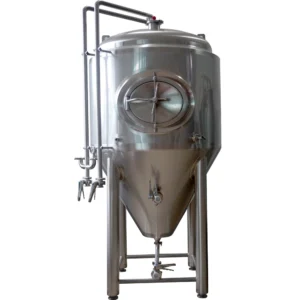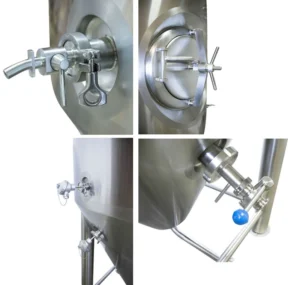A Comprehensive Guide to Beer Fermentation Tanks: Features, Benefits, and Applications
Beer fermentation tanks are essential components in any brewery, playing a crucial role in turning wort into beer through the fermentation process. Whether you’re running a small brewpub, a growing craft brewery, or a large-scale brewing operation, choosing the right fermentation tank is key to ensuring consistent, high-quality beer production. In this article, we’ll dive deep into the features, benefits, and applications of beer fermentation tanks, specifically focusing on the 5BBL, 7BBL, and 10BBL tanks used in brewing operations.
What Is a Beer Fermentation Tank?
A beer fermentation tank is a specialized vessel used during the fermentation process, where the yeast is added to cooled malt wort to convert sugars into alcohol and carbon dioxide. This process is the heart of brewing, and controlling various factors like temperature, yeast management, and pressure is critical to producing a quality end product.

The tanks are generally made from SUS304 stainless steel, which is resistant to corrosion and provides a hygienic surface to prevent contamination. They come in various capacities, commonly measured in barrels (BBL), where 1 BBL is approximately 31 gallons or 117 liters. For smaller to mid-sized brewing operations, tanks in the 5BBL, 7BBL, and 10BBL range are often used.
Features of Beer Fermentation Tanks
Beer fermentation tanks, regardless of capacity, share several core features that make them ideal for commercial brewing:
- Stainless Steel Construction (SUS304): The tanks are built using high-quality stainless steel (SUS304), which is known for its strength, corrosion resistance, and durability. Stainless steel ensures that the beer stays pure, without being affected by contaminants or unwanted flavors.
- Conical Bottom Design: All fermentation tanks feature a conical bottom, which helps with yeast management. The shape allows the yeast to collect at the bottom during fermentation, facilitating easy removal and reuse, which is especially useful in continuous brewing operations.
- Cooling Jacket: Temperature control is critical in fermentation. The tanks are equipped with a cooling jacket that allows precise regulation of the fermentation temperature, ensuring that yeast activity occurs within the ideal range. This also shortens the fermentation cycle, resulting in more efficient production.
- Pressure Handling: These tanks can handle internal pressures that result from the fermentation process. The working pressure for most tanks is around 14 PSI, and the test pressure is typically higher, around 43 PSI. This ensures that the tanks can safely handle the carbonation process and fermentation under pressure.
- CIP System: Cleaning is a crucial aspect of brewery operations. Fermentation tanks are fitted with CIP (Clean-in-Place) systems, which allow for automatic cleaning without disassembly. This ensures that every surface inside the tank is sanitized thoroughly, minimizing contamination risks.

Understanding the Differences: 5BBL, 7BBL, and 10BBL Fermentation Tanks
Let’s compare the three most commonly used tank sizes: 5BBL, 7BBL, and 10BBL. Each is suited for different brewing needs based on the size of the operation and the production volume required.
5BBL Fermentation Tank
The 5BBL (590 liters) tank is perfect for small breweries or brewpubs producing smaller batches. It offers:
- Compact dimensions, making it ideal for limited space setups.
- Efficient yeast discharge through the conical bottom design.
- Versatile applications for smaller-scale beer production with easy temperature control via the cooling jacket.
This tank is best suited for breweries that focus on smaller batches or more experimental brewing processes, where a higher turnover of different beer styles is needed.
7BBL Fermentation Tank
The 7BBL (820 liters) tank offers a larger production volume, making it ideal for growing breweries. Key benefits include:
- Slightly larger dimensions than the 5BBL tank, allowing for medium-scale production without requiring significant space.
- Improved cooling efficiency with the dual-zone cooling jacket, covering both the cylindrical body and conical bottom.
- The ability to manage larger quantities of yeast and handle increased fermentation volumes.
For breweries that are expanding their product range or need to brew larger batches consistently, the 7BBL tank provides an excellent balance between capacity and efficiency.
10BBL Fermentation Tank
The 10BBL (1170 liters) tank is suited for more extensive operations or breweries looking to increase their production output. It includes:
- The largest capacity among the three, allowing for high-volume brewing.
- The most efficient cooling control system due to its larger surface area, ensuring even temperature distribution throughout the fermentation process.
- Superior yeast management with the conical bottom design, which facilitates the separation and reuse of yeast in larger batches.
The 10BBL tank is a great option for breweries scaling up their operations, as it can handle more significant production volumes while maintaining high-quality standards.
5BBL, 7BBL, and 10BBL Beer Fermentation Tanks focusing on the differences between each model:
| Feature | 5BBL | 7BBL | 10BBL |
|---|---|---|---|
| Capacity | 5BBL (~590 liters) | 7BBL (~820 liters) | 10BBL (~1170 liters) |
| Tank Dimensions | Height: 2400mm, Diameter: 950mm | Height: 2530mm, Diameter: 1000mm | Height: 2670mm, Diameter: 1150mm |
| Volume Difference | Lower capacity; suitable for smaller brewpubs producing small batches | Mid-range capacity for medium production | Larger capacity for more industrial-level or growing breweries |
| Floor Space | Requires less floor space | Slightly larger footprint | Requires the most floor space due to larger capacity |
| Fermentation Batch Size | Ideal for small batch production | Produces 230 liters more per batch compared to 5BBL | Produces 350 liters more per batch compared to 7BBL |
| Cooling Jacket Zones | Dual-zone, but smaller area | Dual-zone, slightly larger | Dual-zone with the largest cooling area, allowing more precise temperature control |
| CO2 Recovery and Washing | Available, but smaller gas volume | Larger CO2 volume handling | Handles larger CO2 volumes for more extensive recovery |
| Conical Bottom Efficiency | Yeast separation and management for smaller batches | Handles slightly more yeast discharge efficiently | Most efficient yeast management for larger batches due to bigger conical area |
| Pressure Range | Similar across all tanks | Similar across all tanks | Similar across all tanks |
| Application | Best suited for small-scale brewing, brewpubs, and limited space operations | Suitable for mid-sized craft breweries producing medium-scale batches | Ideal for breweries aiming to increase production and scale |
Key Differences:
- Capacity: The 5BBL is suitable for small-scale brewing, 7BBL fits mid-sized brewing needs, while 10BBL is designed for larger batches or growing breweries.
- Dimensions: The height and diameter increase progressively from 5BBL to 10BBL, meaning the larger tanks require more space and are ideal for breweries expanding their operations.
- Batch Size: The 10BBL tank offers the most significant increase in batch production, making it the best choice for breweries looking to meet higher demand.
- Cooling Jacket Zones: Although all models feature dual-zone cooling, the 10BBL tank’s larger surface area allows for more efficient temperature management.
- CO2 Recovery: The larger tanks (7BBL and 10BBL) can handle more CO2, making them more efficient for operations looking to reduce waste and reuse CO2.
- Yeast Management: The conical bottom design across all models supports yeast collection, but the larger the tank, the more efficient yeast discharge and management become due to increased tank height and conical bottom size.
CO2 Recovery and Sustainability
One of the standout features in these tanks is their ability to perform CO2 washing and recovery. The closed design allows brewers to capture and reuse CO2 produced during fermentation. This not only reduces waste but also helps in reducing operational costs by allowing breweries to recycle the gas for future use. Additionally, these tanks can ferment beer under pressure, which improves the carbonation process, producing more stable, consistent results.
Applications and Versatility
Beer fermentation tanks are versatile and can be used for various beer styles, from traditional lagers and ales to more experimental craft brews. Here’s where these tanks are most commonly applied:
- Small Breweries and Brewpubs: The 5BBL tank is a popular choice for smaller operations with limited space but consistent demand for a variety of beer styles.
- Growing Breweries: Breweries looking to increase their production or scale up operations often choose the 7BBL tank due to its mid-range capacity, offering flexibility for brewing larger batches while still catering to seasonal or experimental brews.
- Larger Operations: The 10BBL fermentation tank is suited for breweries with higher production demands. Its capacity makes it a cost-effective choice for producing large batches while maintaining quality control through advanced temperature and pressure management systems.
Choosing the Right Fermentation Tank
Selecting the right fermentation tank depends on various factors:
- Production Needs: Smaller brewpubs may prefer the 5BBL tank, while a growing craft brewery might opt for the 7BBL or 10BBL tanks depending on their batch size requirements.
- Space Considerations: If space is limited, a smaller tank like the 5BBL or 7BBL may be ideal, but for larger facilities with room for expansion, the 10BBL tank provides more long-term value.
- Sustainability Goals: If your brewery aims to reduce waste and improve sustainability, the CO2 recovery and pressure fermentation capabilities in these tanks will play a significant role in achieving those goals.
Conclusion
Beer fermentation tanks are the backbone of every brewing operation. Whether you’re a small craft brewery or a larger commercial operation, tanks like the 5BBL, 7BBL, and 10BBL models provide the flexibility, control, and efficiency needed to produce high-quality beer. With features like precise temperature control, efficient yeast management, and CO2 recovery, these tanks are designed to optimize the fermentation process and contribute to the production of consistent, flavorful beers.
Investing in the right fermentation tank will not only improve the quality of your beer but also increase your brewery’s overall efficiency, making it easier to scale operations as demand grows. Whether you’re just starting or looking to upgrade, these tanks are built to last and deliver consistent results with every batch.


